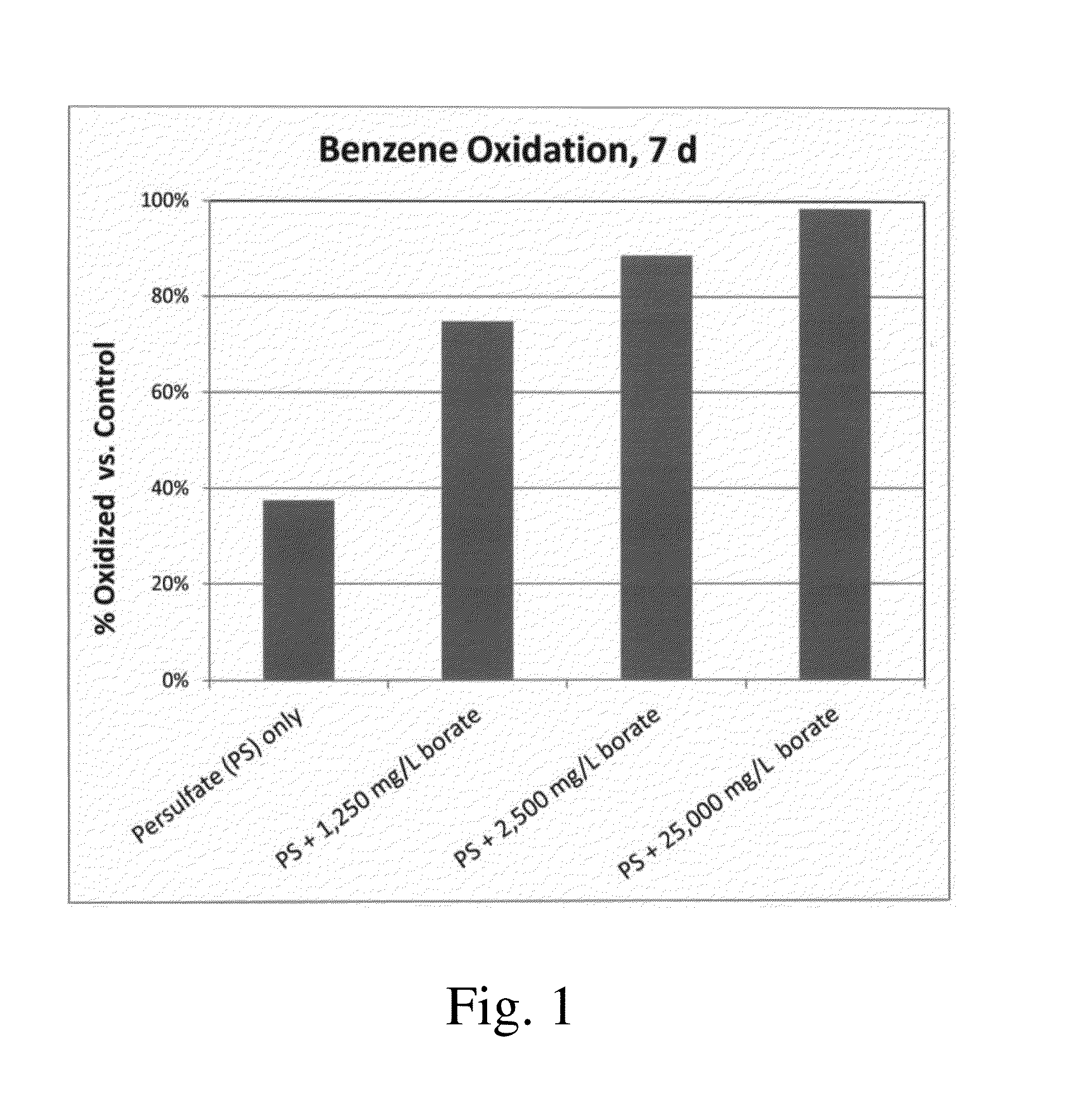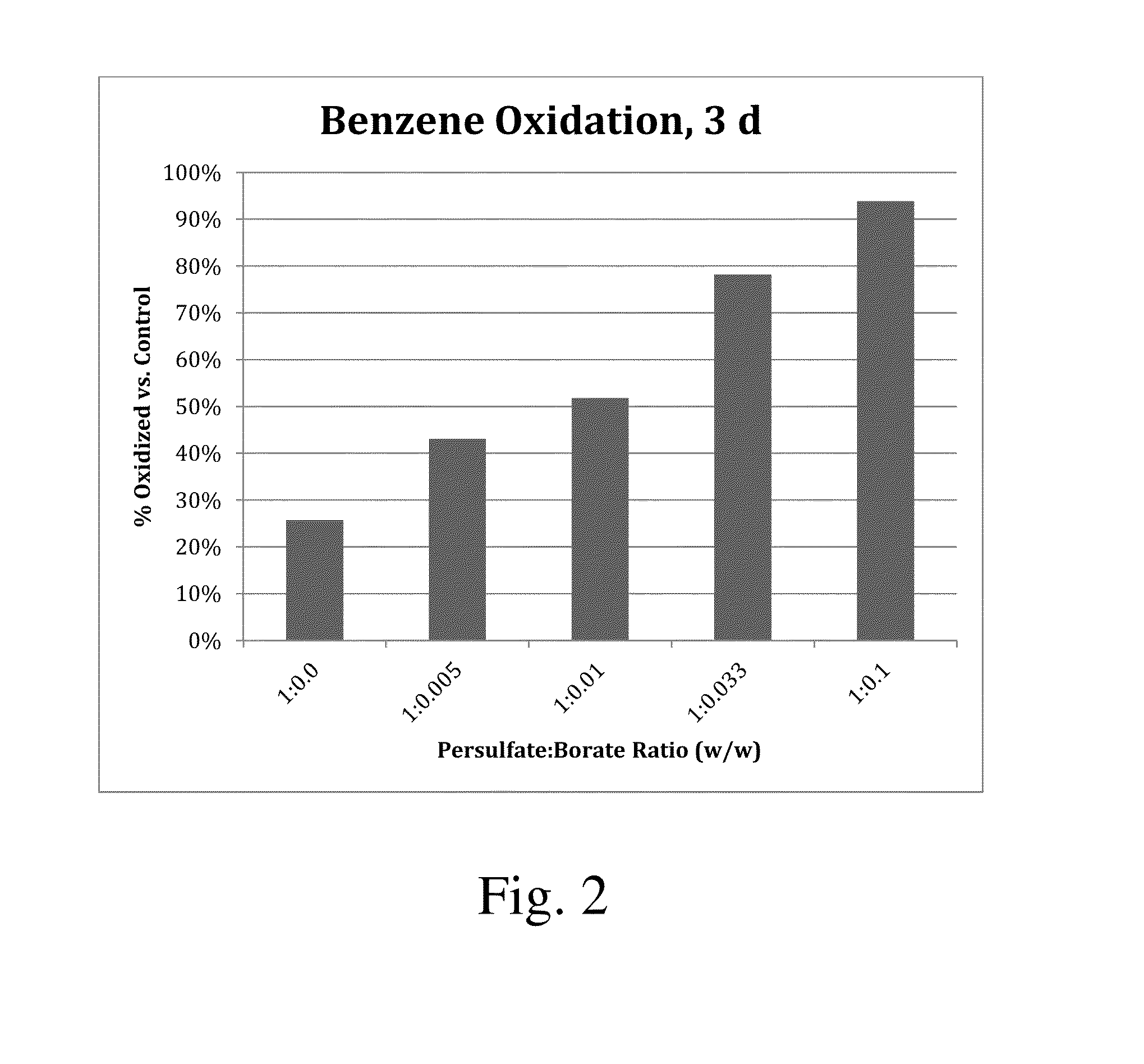Enhanced chemical oxidation
a technology of chemical oxidation and enhanced oxidation, which is applied in the field of enhanced chemical oxidation, can solve the problems of limited conventional persulfate activation options for environmental remediation, metal-based methods (e.g., iron) are known to be less effective on hydrocarbon contaminants, and thermal persulfate activation is possible but very costly, so as to improve the performance of persulfate in oxidation reactions, improve the effect of oxidation efficiency and safety
- Summary
- Abstract
- Description
- Claims
- Application Information
AI Technical Summary
Benefits of technology
Problems solved by technology
Method used
Image
Examples
example 1
[0025]Five conditions were tested in airtight glass vials with polytetrafluoroethylene (PTFE)-lined caps. Each experiment began with approximately 200 mg / L benzene in 20 mL of water solution. The control condition contained only benzene in water. Four other conditions were tested with 0.1 M sodium persulfate (PS) added. These included persulfate only, and persulfate with sodium borate at 1,250 mg / L, 2,500 mg / L, and 25,000 mg / L as Na2B4O7. After 7 days, the benzene concentration was measured in each solution, and the results are shown in FIG. 1. The control solution contained 195 mg / L of benzene, exhibiting little or no losses of benzene over the 7-day period. Sodium persulfate alone oxidized a small fraction of the benzene (38%), whereas the borate-amended samples exhibited enhanced oxidation of benzene, between 75% and 99% depending on the loading. Percentage of benzene oxidized increased as the loading of borate increased, demonstrating that the borate enhances the rate of oxidati...
example 2
[0026]Six conditions were tested in airtight glass vials with PTFE-lined caps. Each experiment began with approximately 400 mg / L benzene in 20 mL of water solution. The control condition contained only benzene in water. Five other conditions were tested with 0.5 M sodium persulfate (PS) added. These included persulfate alone and persulfate with sodium borate (SB) at 595, 1,190, 3,570, and 11,900 mg / L as Na2B4O7. These levels represent persulfate:borate weight ratios of 1:0, 1:0.005, 1:0.01, 1:0.033, and 1:0.1, respectively. After 3 days, the benzene concentration was measured in each solution, and the results are shown in Table 1 and FIG. 2. The control solution contained 418 mg / L of benzene, exhibiting little or no losses of benzene over the 3-day period. Sodium persulfate alone oxidized a small fraction of benzene (26%), whereas the borate-amended samples exhibited enhanced oxidation of benzene, between 43% and 94% depending on the loading. Percentage of benzene oxidized increased...
example 3
[0027]Oxidation trials of nine contaminants were tested in airtight glass vials with PTFE-lined caps. These contaminants were benzene, toluene, ethylbenzene, o-xylene, tetrachloroethylene (PCE), trichloroethylene (TCE), 1,4-dioxane, dichloroethane (DCA) and methyl tert-butyl ether (MTBE). Contaminant starting concentrations were individually selected within the range of 10 to 500 mg / L. Each control sample contained only the contaminant and water. The treated samples contained 0.5 M persulfate with sodium borate (SB) at 11,750 mg / L as Na2B4O7. After 7 days, the contaminant concentration was measured in each solution. The results are reported in Table 2. Borate activated persulfate was able to oxidize over 90% of all contaminants versus control samples in 7 days.
TABLE 2Contaminant Concentrations after 7 Days (mg / L)Percentage ofFinal ControlFinal TreatedContaminantTargetConcentrationConcentrationOxidized vs.Contaminant(mg / L)(mg / L)ControlBenzene4172 99%Toluene15999+%Ethylbenzene1994+%o...
PUM
| Property | Measurement | Unit |
|---|---|---|
| concentrations | aaaaa | aaaaa |
| chemical oxidation | aaaaa | aaaaa |
| weight | aaaaa | aaaaa |
Abstract
Description
Claims
Application Information
 Login to View More
Login to View More - R&D
- Intellectual Property
- Life Sciences
- Materials
- Tech Scout
- Unparalleled Data Quality
- Higher Quality Content
- 60% Fewer Hallucinations
Browse by: Latest US Patents, China's latest patents, Technical Efficacy Thesaurus, Application Domain, Technology Topic, Popular Technical Reports.
© 2025 PatSnap. All rights reserved.Legal|Privacy policy|Modern Slavery Act Transparency Statement|Sitemap|About US| Contact US: help@patsnap.com


